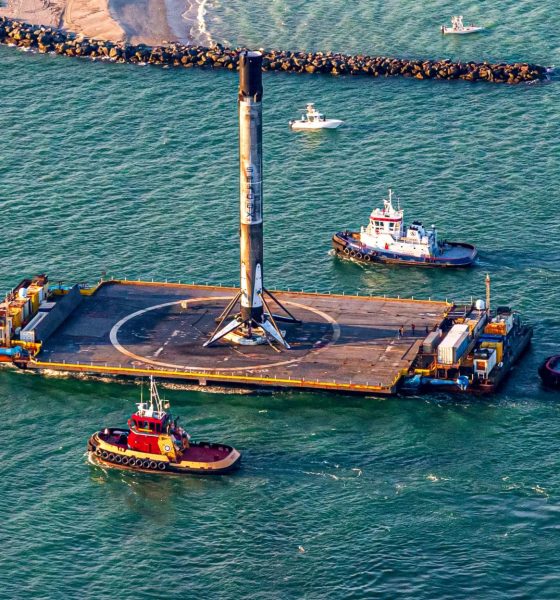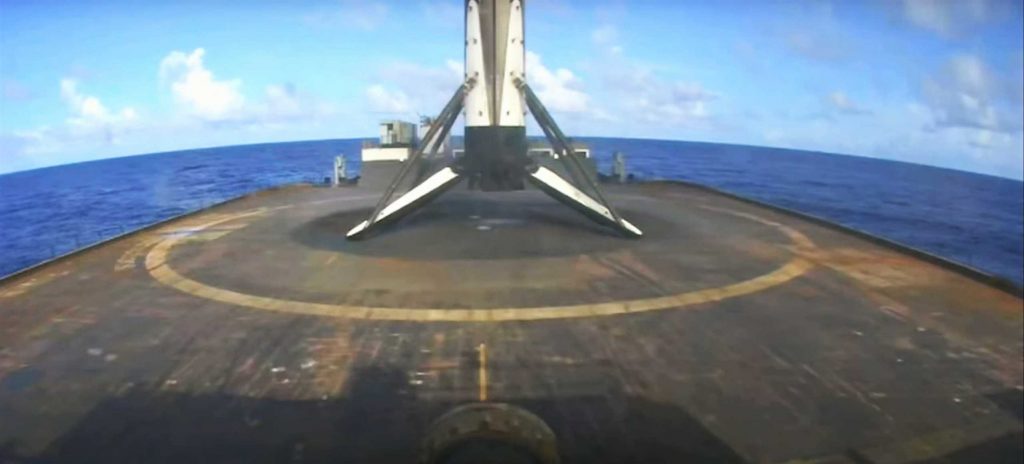

News
SpaceX’s second rocket recovery drone ship leaves port during Starlink launch
On October 18th, SpaceX’s second booster recovery ‘drone ship’ left Port Canaveral at the exact same time as a Falcon 9 rocket was launching 60 Starlink satellites a dozen miles to the north.
A remote point-tilt-zoom (PTZ) camera recently installed by NASASpaceflight.com at the port quite literally captured drone ship Just Read The Instructions (JRTI) vacating its berth and a Falcon 9 lifting off on SpaceX’s Starlink-13 mission in the same frame. That one frame helps capture some of the sheer scale and spectacle of the reusable rocket infrastructure SpaceX has built from nothing in a few short years, as well as the feats of spaceflight that reusability has begun to enable.
In essence, in a single camera frame, viewers can watch a massive SpaceX Falcon 9 rocket weighing ~560 metric tons (~1.3 million lbs) and standing 70 meters (~230 ft) tall lift off on the way to a drone ship (Of Course I Still Love You) landing some 630 km (390 mi) downrange and, ultimately, to Earth orbit.
In the foreground, distant rocket exhaust likely glimmering on its deck, an entirely separate football-field-sized drone ship known as Just Read The Instructions (JRTI) begins a journey to an almost identical Atlantic Ocean landing zone to catch a different Falcon 9 rocket’s own Starlink launch and landing three days later.
Around eight minutes after liftoff, Starlink-13 Falcon 9 booster B1051 performed a flawless, bullseye landing on drone ship OCISLY, completing the rocket’s sixth orbital-class launch. If things went well during stage securing operations, OCISLY and JRTI could easily pass just a few miles (or less) apart as JRTI is towed out to – literally – the exact same landing zone.

Starlink-13 complete, SpaceX appears to be on track to launch another Starlink mission just three days later. Known as Starlink-14 or Starlink V1 L14, it will be the namesake 14th launch of operational v1.0 Starlink satellites, also marking SpaceX’s 13th Starlink launch in 2020 and 15th Starlink launch overall. Starlink-14 is scheduled to lift off from Cape Canaveral Air Force Station (CCAFS) Launch Complex 40 (LC-40) no earlier than (NET) 12:36 pm EDT (16:36 UTC), Wednesday, October 21st. L-1d weather forecasts predict a 60% chance of favorable conditions.
As previously discussed on Teslarati, if Starlink-14 launches on schedule or is delayed by less than 72 hours, the Falcon 9 booster supporting it will break SpaceX’s (and thus the world’s) rocket turnaround record.
“NextSpaceflight.com reports that SpaceX has assigned Falcon 9 booster B1060 to Starlink-14. If Starlink-14 lifts off on schedule on October 21st, B1060 will beat out B1058 for the crown of fastest booster turnaround, launching twice in just 48 days. Falcon 9 B1058 set the current world record when it beat NASA’s Space Shuttle (54 days) with a 51-day turnaround earlier this year.”
Teslarati.com – October 15th, 2020

As usual, SpaceX will host an official webcast typically scheduled to begin ~15 minutes before launch. Tune in around 12:20 pm EDT (16:20 UTC) to catch Falcon 9’s Starlink-14 launch and landing live.

Elon Musk
Elon Musk and Tesla AI Director share insights after empty driver seat Robotaxi rides
The executives’ unoccupied tests hint at the rapid progress of Tesla’s unsupervised Robotaxi efforts.

Tesla CEO Elon Musk and AI Director Ashok Elluswamy celebrated Christmas Eve by sharing personal experiences with Robotaxi vehicles that had no safety monitor or occupant in the driver’s seat. Musk described the system’s “perfect driving” around Austin, while Elluswamy posted video from the back seat, calling it “an amazing experience.”
The executives’ unoccupied tests hint at the rapid progress of Tesla’s unsupervised Robotaxi efforts.
Elon and Ashok’s firsthand Robotaxi insights
Prior to Musk and the Tesla AI Director’s posts, sightings of unmanned Teslas navigating public roads were widely shared on social media. One such vehicle was spotted in Austin, Texas, which Elon Musk acknowleged by stating that “Testing is underway with no occupants in the car.”
Based on his Christmas Eve post, Musk seemed to have tested an unmanned Tesla himself. “A Tesla with no safety monitor in the car and me sitting in the passenger seat took me all around Austin on Sunday with perfect driving,” Musk wrote in his post.
Elluswamy responded with a 2-minute video showing himself in the rear of an unmanned Tesla. The video featured the vehicle’s empty front seats, as well as its smooth handling through real-world traffic. He captioned his video with the words, “It’s an amazing experience!”
Towards Unsupervised operations
During an xAI Hackathon earlier this month, Elon Musk mentioned that Tesla owed be removing Safety Monitors from its Robotaxis in Austin in just three weeks. “Unsupervised is pretty much solved at this point. So there will be Tesla Robotaxis operating in Austin with no one in them. Not even anyone in the passenger seat in about three weeks,” he said. Musk echoed similar estimates at the 2025 Annual Shareholder Meeting and the Q3 2025 earnings call.
Considering the insights that were posted Musk and Elluswamy, it does appear that Tesla is working hard towards operating its Robotaxis with no safety monitors. This is quite impressive considering that the service was launched just earlier this year.
Elon Musk
Starlink passes 9 million active customers just weeks after hitting 8 million
The milestone highlights the accelerating growth of Starlink, which has now been adding over 20,000 new users per day.

SpaceX’s Starlink satellite internet service has continued its rapid global expansion, surpassing 9 million active customers just weeks after crossing the 8 million mark.
The milestone highlights the accelerating growth of Starlink, which has now been adding over 20,000 new users per day.
9 million customers
In a post on X, SpaceX stated that Starlink now serves over 9 million active users across 155 countries, territories, and markets. The company reached 8 million customers in early November, meaning it added roughly 1 million subscribers in under seven weeks, or about 21,275 new users on average per day.
“Starlink is connecting more than 9M active customers with high-speed internet across 155 countries, territories, and many other markets,” Starlink wrote in a post on its official X account. SpaceX President Gwynne Shotwell also celebrated the milestone on X. “A huge thank you to all of our customers and congrats to the Starlink team for such an incredible product,” she wrote.
That growth rate reflects both rising demand for broadband in underserved regions and Starlink’s expanding satellite constellation, which now includes more than 9,000 low-Earth-orbit satellites designed to deliver high-speed, low-latency internet worldwide.
Starlink’s momentum
Starlink’s momentum has been building up. SpaceX reported 4.6 million Starlink customers in December 2024, followed by 7 million by August 2025, and 8 million customers in November. Independent data also suggests Starlink usage is rising sharply, with Cloudflare reporting that global web traffic from Starlink users more than doubled in 2025, as noted in an Insider report.
Starlink’s momentum is increasingly tied to SpaceX’s broader financial outlook. Elon Musk has said the satellite network is “by far” the company’s largest revenue driver, and reports suggest SpaceX may be positioning itself for an initial public offering as soon as next year, with valuations estimated as high as $1.5 trillion. Musk has also suggested in the past that Starlink could have its own IPO in the future.
News
NVIDIA Director of Robotics: Tesla FSD v14 is the first AI to pass the “Physical Turing Test”
After testing FSD v14, Fan stated that his experience with FSD felt magical at first, but it soon started to feel like a routine.

NVIDIA Director of Robotics Jim Fan has praised Tesla’s Full Self-Driving (Supervised) v14 as the first AI to pass what he described as a “Physical Turing Test.”
After testing FSD v14, Fan stated that his experience with FSD felt magical at first, but it soon started to feel like a routine. And just like smartphones today, removing it now would “actively hurt.”
Jim Fan’s hands-on FSD v14 impressions
Fan, a leading researcher in embodied AI who is currently solving Physical AI at NVIDIA and spearheading the company’s Project GR00T initiative, noted that he actually was late to the Tesla game. He was, however, one of the first to try out FSD v14.
“I was very late to own a Tesla but among the earliest to try out FSD v14. It’s perhaps the first time I experience an AI that passes the Physical Turing Test: after a long day at work, you press a button, lay back, and couldn’t tell if a neural net or a human drove you home,” Fan wrote in a post on X.
Fan added: “Despite knowing exactly how robot learning works, I still find it magical watching the steering wheel turn by itself. First it feels surreal, next it becomes routine. Then, like the smartphone, taking it away actively hurts. This is how humanity gets rewired and glued to god-like technologies.”
The Physical Turing Test
The original Turing Test was conceived by Alan Turing in 1950, and it was aimed at determining if a machine could exhibit behavior that is equivalent to or indistinguishable from a human. By focusing on text-based conversations, the original Turing Test set a high bar for natural language processing and machine learning.
This test has been passed by today’s large language models. However, the capability to converse in a humanlike manner is a completely different challenge from performing real-world problem-solving or physical interactions. Thus, Fan introduced the Physical Turing Test, which challenges AI systems to demonstrate intelligence through physical actions.
Based on Fan’s comments, Tesla has demonstrated these intelligent physical actions with FSD v14. Elon Musk agreed with the NVIDIA executive, stating in a post on X that with FSD v14, “you can sense the sentience maturing.” Musk also praised Tesla AI, calling it the best “real-world AI” today.








